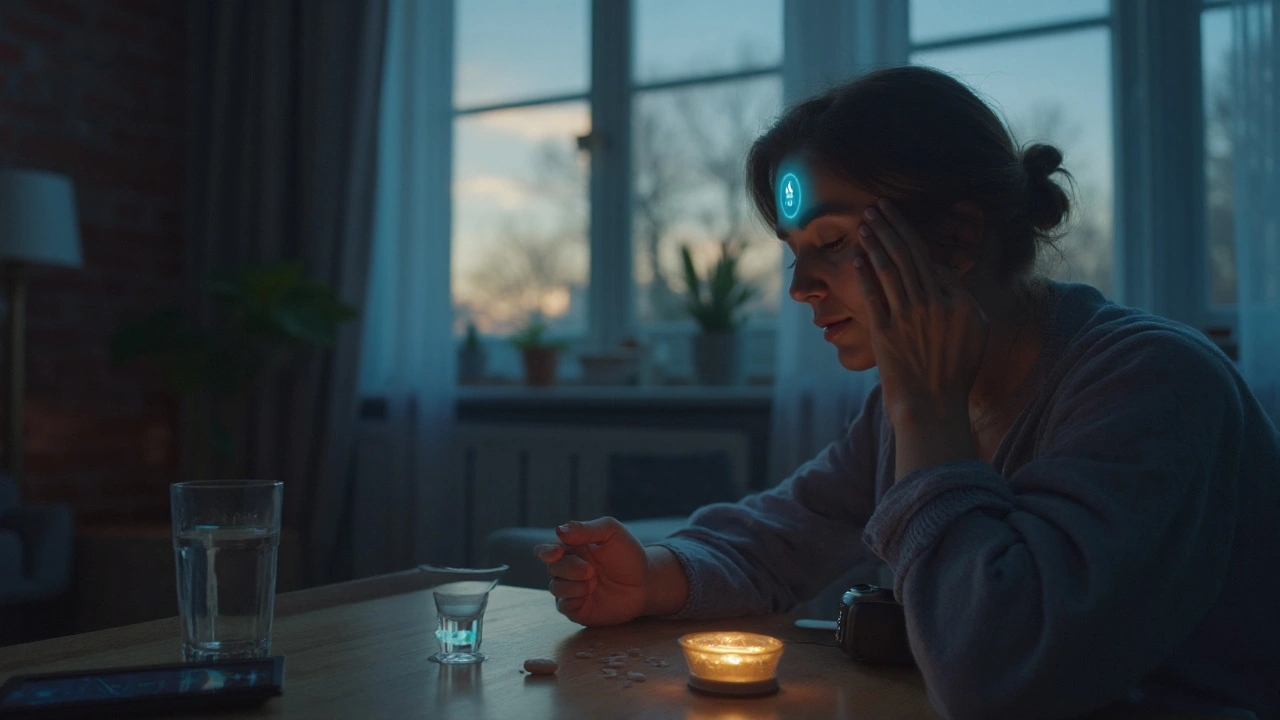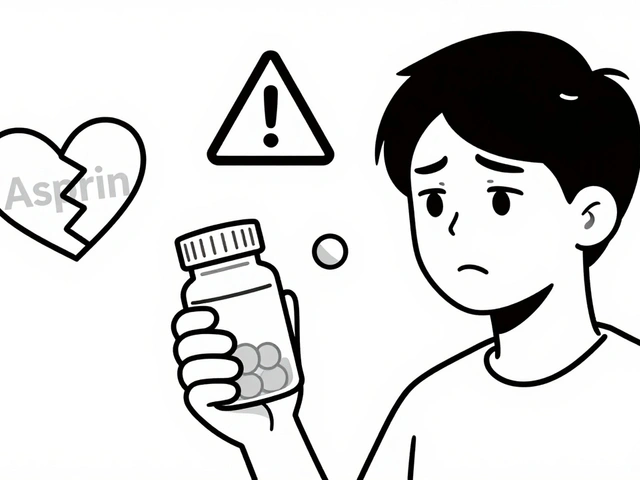
You get hit by a migraine. You want the pain to end now, but you also want fewer attacks next month. That’s the gap this duo tries to close: quick relief from a fast-acting triptan plus a skill that retrains your nervous system between attacks. If you’ve bounced between pills and “mind-body” apps, here’s a grounded plan that blends both without the hype.
TL;DR:
- This approach pairs acute treatment (rizatriptan) with prevention (biofeedback). Many people see faster relief now and fewer headache days over time.
- Rizatriptan 5-10 mg works best when taken early at headache onset; keep use under 10 days/month to avoid medication overuse headache.
- Biofeedback (thermal/EMG/HRV) usually takes 6-10 sessions plus home practice; about half of users cut monthly migraines by at least 50% in trials.
- Watch for contraindications: heart disease, uncontrolled blood pressure, MAO inhibitors, certain rare migraine subtypes. Discuss propranolol dosing limits.
- Track outcomes for 8-12 weeks: pain freedom at 2 hours, monthly frequency, rescue use, and function. Adjust with your clinician if you’re not hitting targets.
What jobs are you here to get done?
- Figure out if rizatriptan and biofeedback make sense for your kind of migraine.
- Learn the exact timing, dose, and safety steps for rizatriptan.
- Start a practical biofeedback routine at home or with a coach.
- Avoid pitfalls like medication overuse headache and bad timing during aura.
- Measure results and know when to pivot to alternatives.
How this duo works: fast relief + long-game control
Rizatriptan is a triptan. It activates 5-HT1B/1D receptors on cranial vessels and trigeminal nerves. In plain English: it slows the migraine pain signal, tightens dilated vessels a bit, and blocks CGRP release. In large trials and meta-analyses, 10 mg delivers two-hour pain freedom for roughly 35-40% of attacks vs about 20% on placebo, with onset often within 30-60 minutes. The orally disintegrating tablet (ODT) helps if nausea makes swallowing hard, but it doesn’t beat the standard tablet on speed; it’s just easier to take when you feel sick. The typical adult max is 30 mg/day. If you take propranolol, the recommended rizatriptan dose is 5 mg with a daily max of 15 mg because propranolol raises rizatriptan levels. These details come straight from prescribing information and pooled efficacy analyses used in headache society guidelines.
Biofeedback trains you to adjust body signals you don’t usually control-muscle tension (EMG), skin temperature (thermal), and heart rhythm (HRV). You get real-time feedback on a screen and practice until your body learns a calmer baseline. The American Academy of Neurology and the American Headache Society have long endorsed biofeedback and relaxation-based therapies as effective preventive options. AAN’s guideline update on non-drug prevention (2012) flagged biofeedback as Level A for migraine prevention, and later statements from headache societies continue to support it as first-line behavioral therapy. Meta-analyses report that 45-60% of patients achieve at least a 50% reduction in monthly headache frequency after a course of biofeedback plus practice. Side effects are minimal, and it pairs well with medication.
Why combine them? Triptans help you win the current fight; biofeedback helps you see fewer fights. Many people end up using fewer triptan doses per month after biofeedback training. Behavioral skills can also blunt stress-related triggers and may reduce allostatic load-your system’s wear and tear-so the next trigger is less likely to cross your personal threshold for an attack.
What does “good” look like in real life? Over about 8-12 weeks, a solid plan often produces: faster pain relief during attacks (more two-hour pain freedom), fewer headache days per month (1-4 fewer is common), less rescue medication use, and better function at work or school. If those dials don’t move, we tweak-timing of dosing, add an NSAID adjunct when appropriate, or adjust the biofeedback protocol.
| Feature | Rizatriptan (acute) | Biofeedback (preventive) |
|---|---|---|
| Main role | Abort current attack | Reduce future attack frequency/intensity |
| Onset of benefit | 30-60 minutes | 4-8 weeks (with regular sessions) |
| Two-hour pain freedom | ~35-40% (10 mg), placebo ~20% | Not applicable (prevention) |
| Monthly migraine day reduction | Indirect (less carryover if treated early) | ~1-4 fewer days/month on average |
| Common side effects | Tingling, tightness/pressure, fatigue, dizziness | Minimal; occasional fatigue during training |
| Key risks/limits | Cardiovascular contraindications; MOH if ≥10 days/month | Time/engagement; access to trained provider/equipment |
| Who may benefit | Most adults with migraine without major vascular disease | Most with episodic or chronic migraine, including youth |
| Evidence sources | Randomized trials; prescribing info; AHS recommendations | AAN/AHS guidelines; randomized trials; meta-analyses |
Notes on safety and fit:
- Skip rizatriptan if you have coronary disease, prior stroke/TIA, uncontrolled hypertension, or if you use MAO inhibitors. It’s not indicated for hemiplegic migraine or migraine with brainstem aura.
- Use fewer than 10 triptan days/month to avoid medication overuse headache (MOH). Count “days used,” not “pills.”
- Biofeedback is safe for teens and adults. Many pediatric headache clinics use thermal or EMG biofeedback with strong results.
- Pregnancy and lactation: data are limited; discuss risks/benefits with your obstetric provider. Behavioral therapy is often favored in pregnancy.

Step-by-step: use rizatriptan smartly, build a biofeedback routine
If you only change one thing: take rizatriptan early in the headache phase, not during aura. Triptans work best when pain is mild and before central sensitization sets in.
Your acute attack playbook
- At the first sign of headache (not just aura), take rizatriptan 10 mg (or 5 mg if your clinician set that dose). If you’re on propranolol, use 5 mg instead; max 15 mg/day.
- If nausea is strong, use the ODT formulation. It melts and is easy to keep down.
- Pair with an NSAID if allowed (e.g., naproxen) when attacks tend to recur. This combo lowers the chance of pain returning later. Ask your clinician about stomach and kidney risks first.
- Hydrate and reduce sensory load. Dark, quiet room. A cool pack on the forehead helps some; a warm pack on tight neck muscles helps others.
- Wait two hours. If the headache is still significant, a second rizatriptan dose may be used (adults), staying within the daily max. Do not combine with other triptans or ergot drugs within 24 hours.
- Track results in a simple log: time of dose, pain at 2 hours (0-10), side effects, whether the pain returned within 24 hours, and whether you needed rescue meds.
Mini decision tree during an attack
- If you’re in aura without pain: wait for the headache to begin; then dose promptly.
- Woke up with severe pain (high likelihood of central sensitization): take rizatriptan + allowed NSAID + anti-nausea med if prescribed. Use your breathing drill (below) while the meds kick in.
- If you already used rizatriptan ≥10 days this month: don’t dose again; call your clinician about a different plan to avoid MOH.
- Two attacks in a row didn’t respond: time to reassess. Check timing (too late?), dose (too low?), interactions (propranolol?), and consider alternatives (gepants/ditans) with your clinician.
Your biofeedback routine
- Pick your mode: thermal (hand-warming), EMG (forehead/neck tension), or HRV (paced breathing with heart rhythm feedback). HRV and thermal are easiest at home.
- Find a provider or program: look for BCIA-certified clinicians for in-person EMG/thermal. Many clinics run 6-10 weekly sessions. If you go remote, choose a reputable HRV app with a chest-strap or finger sensor and clear training plans.
- Set a schedule: aim for 15-20 minutes, 5 days/week, for 8 weeks. Keep two short sessions on attack-free days; add a 5-minute “rescue” session at the earliest prodrome signs (yawning, neck pain, light sensitivity).
- Use a simple protocol (HRV example): 4.5-6 breaths per minute (about a 4-second inhale, 6-second exhale), shoulders relaxed, jaw unclenched, tongue resting on the roof of your mouth. Watch the feedback trace and keep it smooth. If your mind wanders, bring it back to the exhale.
- For thermal biofeedback: place the sensor on a fingertip, watch temperature rise as you release hand/forearm tension and picture warmth flowing to your hands. Add a quiet, slow exhale to help dilation.
- For EMG: sensors go on the frontalis or upper trapezius. Your goal is a lower baseline tension. Practice small releases-think 10% less clench, then another 10%. Hold, breathe, repeat.
- Review progress every two weeks: are baseline signals calmer? Are you practicing on “good” days, not just crisis days? Any session that feels like pushing a boulder uphill, shorten it rather than skip it.
Combine the two in daily life
- Use biofeedback on non-migraine days to move your baseline. That’s where the prevention happens.
- During a shaky morning or early prodrome, do 5 minutes of HRV breathing before caffeine. If a headache emerges, you’ve at least lowered the starting tension.
- On treatment days, do a gentle 5-8 minute breathing session right after dosing. You’re not replacing the pill; you’re smoothing the nervous system while the medication sets in.
- Track your “free days” and “function” as much as pain. Many people notice they get back to life faster even when some pain lingers.
Pro tips that save you time
- Take rizatriptan with a small sip of water. Large volumes during nausea can backfire.
- If sleep is a reliable reset for you, a 20-30 minute nap during early treatment often boosts relief.
- Create a 10-item “low-friction” kit: ODTs, allowed NSAID, anti-nausea med if prescribed, water bottle, eye mask, earplugs, cold pack, heat wrap, glucose snack, and your sensor or app.
- Put a hard stop on triptan use at 9 days/month. That buffer helps you avoid crossing the MOH line by accident.

Tools, trade-offs, and answers: expectations, costs, checklists, FAQ
Is this duo right for you? Run this quick checklist
- I get episodic or chronic migraine and want both fast relief and fewer attacks.
- I don’t have coronary disease, prior stroke/TIA, or uncontrolled hypertension.
- I’m not on an MAO inhibitor, and I understand the propranolol dose rule.
- I can practice biofeedback 15-20 minutes most days for 8 weeks.
- I’m willing to keep a simple migraine log for 2-3 months.
What to measure (so you know it’s working)
- Two-hour pain freedom rate (per month).
- Monthly migraine days and acute medication days.
- Rescue medication need after dosing.
- Function: missed work/school hours and activity scores.
Costs and access (typical ranges in 2025)
- Rizatriptan: widely generic. Cash prices vary; many pay a modest copay. ODT may cost more than standard tablets.
- Biofeedback: clinic sessions often $75-$200 each; 6-10 sessions are common. Some insurers cover when billed as behavioral therapy for migraine; pre-authorization helps.
- Home HRV gear: finger sensors or chest straps range from $50-$150; apps may be free or subscription-based.
Doctor talk script (copy/paste into your portal)
- “I’m using rizatriptan early at headache onset, under 10 days/month. Can we confirm my dose, especially if I’m on propranolol?”
- “I want to start biofeedback (HRV or thermal). Can you refer me to a BCIA-certified provider or endorse a home protocol?”
- “If I get recurrence after initial relief, is adding naproxen appropriate for me?”
- “What’s our metric for success at 8-12 weeks, and what’s Plan B if I’m not there?”
Evidence snapshots and credibility
- Triptan efficacy: Multiple randomized trials and pooled analyses show rizatriptan 10 mg achieves two-hour pain freedom around 35-40%, with meaningful relief in more. This is consistent with the drug’s prescribing information and comparative triptan data summarized by the American Headache Society.
- Biofeedback: AAN’s 2012 guideline on nonpharmacologic prevention rated biofeedback (alone or with relaxation) as effective for migraine prevention, and later AHS position statements continue to recommend it as a first-line behavioral option. Meta-analyses report moderate effect sizes and 45-60% responder rates (≥50% fewer migraines).
- MOH thresholds: International Classification of Headache Disorders and headache society guidance place the triptan cutoff at ≥10 days/month.
FAQ
- Can I use rizatriptan during aura? No. Triptans work best at the start of head pain. They’re not for pure aura without pain.
- What if I’m on propranolol? Use 5 mg rizatriptan per dose and do not exceed 15 mg/day. Propranolol increases rizatriptan levels.
- Is serotonin syndrome a real risk with SSRIs/SNRIs? It’s rare. Still, know the signs (agitation, sweating, shivering, fast heart rate) and seek care if they appear. Discuss with your prescriber.
- Can teens use this combo? Rizatriptan is approved for many pediatric patients; dosing is weight-based and typically limited to a single dose in 24 hours. Biofeedback is widely used in pediatric headache clinics and often works well.
- What if rizatriptan fails often? Check timing first-dose at mild pain. Consider adding an NSAID if appropriate. If failures persist, your clinician may switch to another triptan, a gepant (ubrogepant, rimegepant, zavegepant), or a ditan (lasmiditan).
- Can I use CGRP preventives with this plan? Yes. CGRP monoclonal antibodies (erenumab, fremanezumab, galcanezumab, eptinezumab) or preventive gepants (atogepant, rimegepant) can sit beside biofeedback and leave rizatriptan for breakthrough attacks.
- Is this safe in pregnancy? Medication choices shift in pregnancy. Many providers favor behavioral therapies like biofeedback then. Discuss any triptan use with your obstetric provider.
- Any red flags that mean “don’t use a triptan”? Chest pain with exertion, known coronary disease, prior stroke/TIA, uncontrolled blood pressure, and rare subtypes like hemiplegic migraine or migraine with brainstem aura.
- Do I need fancy hardware for biofeedback? Not always. A simple finger temperature sensor or a chest-strap HR monitor with a solid HRV app can work. For EMG training, in-person sessions help.
- Can I drive after taking rizatriptan? If you feel dizzy or very tired, don’t drive. See how you respond before you plan to drive or operate machinery.
Troubleshooting and next steps
- If you get relief but pain keeps coming back later the same day: ask about adding an NSAID when you dose or scheduling a strategic nap. Keep hydration steady and avoid over-caffeine rebounds.
- If nausea ruins your timing: keep ODTs handy, add an antiemetic if prescribed, and consider taking your dose at the very first hint of head pain before nausea spikes.
- If biofeedback feels boring or hard: shorten sessions to 8-10 minutes but keep frequency high. Aim for “some practice, most days.” Stack it with a habit-right after brushing teeth works.
- If your month crosses 8-9 triptan days: bring this to your clinician now and plan preventive upgrades (behavioral + pharmacologic) to dodge MOH.
- If stress is the clear trigger: add 5 minutes of HRV breathing before high-demand events (presentations, flights, long drives). Preventive micro-doses of calm help more than emergency marathons.
- If sleep is messy: anchor a consistent wake time, protect the hour before bed (no heavy screens, dim light), and use a breathing drill to extend exhalation. Poor sleep amplifies migraine risk.
- If you’re not improving at 8-12 weeks: review your log with your clinician. Consider another triptan, a gepant/ditan for acute use, or adding a CGRP preventive. Keep biofeedback if you’ve seen even small gains; often gains compound with time.
Bottom line: pair a precise, early dose of rizatriptan with steady, bite-size biofeedback practice. You get speed for today’s pain and skill for tomorrow’s triggers. That mix tends to move the dials that matter-less downtime, fewer attacks, and a feeling that you’ve finally got a handle on it.




16 Comments
Love this breakdown. I’ve been using rizatriptan for years but never thought to pair it with biofeedback-kinda like giving your nervous system a soft reboot while you’re still in survival mode. Started HRV training last month with a $60 finger sensor and an app called Breathwrk. Didn’t expect to feel less like a shaken soda can by week three. Now I do 5 minutes before coffee, and honestly? My migraines feel less like lightning strikes and more like thunderstorms I can ride out.
OMG YES. This is the migraine hack I didn’t know I needed. Biofeedback feels like yoga for your autonomic nervous system-except instead of chanting ‘om,’ you’re whispering ‘warm hands, calm heart’ while staring at a wiggly line on your phone. I went from 18 migraine days a month to 6. Not magic. Just math. And breathing. And not being a martyr to the caffeine cup.
So you’re telling me I don’t need to suffer like a Victorian widow to get better? 🙃
I tried this combo after my neurologist sighed and said, ‘You’re not getting better because you’re treating symptoms, not the system.’ I was skeptical-until I realized my biofeedback sessions were the only time I didn’t clench my jaw like I was trying to crack a walnut. Now I do 10 minutes before bed and 5 when I feel the buzz. No more 3 a.m. panic attacks from a headache. Also, I stopped counting pills. Started counting peaceful moments. Way better ROI.
I took the 5mg because I’m on propranolol. Took it when the aura ended, not during. Felt better in 40 mins. Did 3 biofeedback sessions this week. Not sure if it’s working yet, but I’m not crying in the shower anymore. That’s a win.
It’s funny how we’ve been sold this binary: either you’re a pill person or a mindfulness person. But the truth is, your body doesn’t care about labels-it just wants to stop screaming. Rizatriptan is the fire extinguisher. Biofeedback is the smoke detector you forgot you installed. I’ve been doing thermal feedback for 6 weeks now. My hands used to be ice cubes even in July. Now? They’re just… cool. Not cold. And I’ve cut my triptan use by 60%. Not because I’m disciplined. Because I finally stopped fighting my nervous system and started negotiating with it. Also, I keep a little journal. Not for my doctor. For me. So I remember I’m not broken. Just tired.
The elegance of this approach lies not in its novelty but in its alignment with neurophysiological reality. Triptans modulate acute nociceptive signaling via serotonin receptors; biofeedback modulates the allostatic load that lowers the threshold for such signaling. The synergy is not additive-it’s multiplicative. The reduction in attack frequency is not merely behavioral adaptation but neuroplastic reorganization. What’s often mislabeled as ‘placebo’ in clinical trials is, in fact, the nervous system’s capacity for self-regulation when given consistent, non-pharmacological cues. The 45-60% responder rate in meta-analyses isn’t anecdotal-it’s emergent. We’re not treating migraines. We’re retraining the brain’s alarm system. And that’s why this isn’t a ‘strategy.’ It’s a paradigm shift.
Anyone who takes triptans more than 5 days a month is just addicted to pain. And biofeedback? Please. If you can’t control your stress, you don’t deserve to be pain-free.
USA invented modern migraine care. Why are you listening to some Indian therapist with a $20 sensor? Real Americans use ice packs, Advil, and a strong will. This biofeedback nonsense is just another woke trend. You want relief? Stop being weak. And stop using ODTs-they’re for people who can’t handle real medicine.
How quaint. You treat a neurological disorder like it’s a yoga retreat. Rizatriptan is a potent vasoconstrictor. Biofeedback is a placebo dressed in wires. The only thing you’re ‘retraining’ is your willingness to believe in magic. If you want real results, get a CGRP monoclonal antibody and stop pretending your breathing is medicine. This post reads like a wellness influencer’s pitch deck.
While the empirical data supporting rizatriptan’s efficacy is robust, the evidence base for biofeedback remains heterogeneous. The AAN’s Level A recommendation, while authoritative, is predicated on studies with significant methodological variability-including small sample sizes, lack of blinding, and inconsistent outcome measures. Furthermore, the 45-60% responder rate cited is derived from meta-analyses that conflate thermal, EMG, and HRV modalities, which possess distinct neurophysiological mechanisms. The conflation of correlation with causation in this post is concerning. One must ask: is the observed reduction in migraine frequency attributable to biofeedback, or to the placebo effect of engaging in a structured, time-intensive behavioral protocol? Until randomized, double-blind, sham-controlled trials confirm efficacy, this remains a hypothesis dressed as a protocol.
I’ve been guiding patients through this exact plan for three years. The hardest part isn’t the meds or the tech-it’s the mindset. People think they need to ‘do it perfectly’-15 minutes every day, no exceptions. But real change happens in the messy middle. Missed a session? Do 3 minutes while waiting for your coffee. Took a triptan on day 11? That’s okay. Just reset your goal for next month. Progress isn’t linear. Healing isn’t a checklist. You’re not failing if you’re still trying.
i tried this and it kinda worked?? i was skeptical but i did the hrv thing with my apple watch and honestly it helped me chill out before work. rizatriptan still saved me on bad days. i dont know if its the breathing or just finally taking the pill early but i havent used it 10 times this month yet which is a first. also my hands arent always cold which is wild. thanks for not making me feel dumb for needing both.
The integration of pharmacological intervention with behavioral neuroregulation represents a paradigm of precision medicine in headache disorders. The temporal alignment of acute pharmacotherapy with preventive neuromodulation-particularly when calibrated to individual autonomic profiles-exemplifies a systems-based approach that transcends reductionist models of care. The data presented are consistent with contemporary clinical guidelines and underscore the importance of patient-centered outcome metrics, including functional restoration and medication burden reduction. This framework should be disseminated as a model for multidisciplinary headache management.
My mom had migraines her whole life. She never took meds. Just prayed. And now she’s dead at 62. I’m not letting my daughter go through that. I’m using the rizatriptan. I’m doing the breathing. I’m tracking everything. And I’m not letting anyone tell me this is ‘new age crap.’ If science says it works, I’m using it. No guilt. No shame. Just survival.
Just read your comment about your mom. That hit hard. I lost my sister to a stroke after years of uncontrolled migraines and medication overuse. I didn’t know biofeedback could’ve helped her until it was too late. That’s why I’m here-not just for me, but so others don’t wait until it’s too late. This isn’t a trend. It’s a lifeline. And if you’re doing the breathing, you’re already winning.